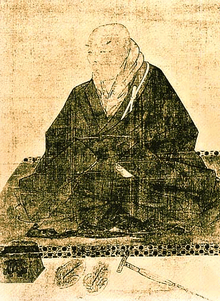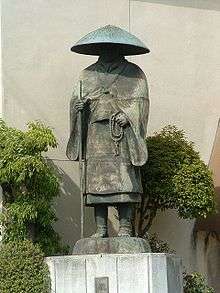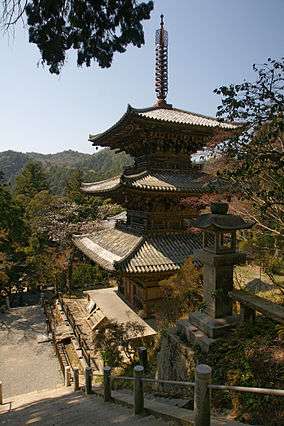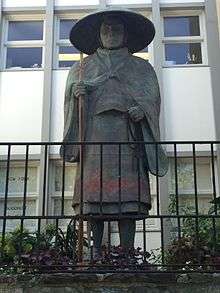Shinran
| Shinran (親鸞) | |
|---|---|
 Shinran's "Portrait of Anjo" at Honganji in Kyoto, Japan. | |
| School | Jōdo Shinshū Buddhism |
| Personal | |
| Born |
May 21, 1173 Heian-kyō, Yamashiro Province (now Kyoto, Japan) |
| Died |
January 16, 1263 (aged 89) Heian-kyō, Yamashiro Province |
| Spouse | Eshinni |
| Children | Kakushinnhi, Zenran, others |
| Senior posting | |
| Title | Founder of Jōdo Shinshū Buddhism |
| Religious career | |
| Teacher | Hōnen |
Shinran (親鸞, May 21, 1173 – January 16, 1263)[1][2] was a Japanese Buddhist monk, who was born in Hino (now a part of Fushimi, Kyoto) at the turbulent close of the Heian Period and lived during the Kamakura Period. Shinran was a pupil of Hōnen and the founder of what ultimately became the Jōdo Shinshū sect in Japan.
Biography
Shinran was born on May 21, 1173, to Lord and Lady Arinori, a branch of the Fujiwara clan, and was given the name Matsuwakamaro. Early in Shinran's life his parents both died. In 1181 and desperate to know what happens after dying, he entered the Shoren-in temple near present-day Maruyama Park in Kyoto at age 9. He wrote this poem on entering: "Like the cherry blossom, the heart planning on tomorrow is ephemeral indeed --what sudden storm may not arise in the middle of the night". Actually aware of his own impermanence, he was desperate to find a solution. He then practiced at Mt. Hiei for the next 20 years of his life. Letters between his wife and daughter indicate that he was a Tendai dōsō (堂僧, "hall monk").[3] Because of his devotion to the practices of the Lotus Sutra on Mt. Hiei, he became known as "the prodigy of Mt. Hiei".
According to his own account to his wife Eshinni (whose letters are preserved at the Hongan-ji), in frustration at his own failures as a monk and at obtaining enlightenment, he took a retreat at the temple of Rokkaku-dō. There, while engaged in intense practice, he experienced a vision in which Avalokitesvara appeared to him as Prince Shōtoku, directing Shinran to another disillusioned Tendai monk named Hōnen.[4] In 1201, Shinran met Hōnen and became his disciple. During his first year under Honen's guidance, at the age of 29, Shinran attained enlightenment, or salvation through Amida's Vow. Though the two only knew each other for a few years, Hōnen entrusted Shinran with a copy of his secret work, the Senchakushū. However his precise status amongst Honen's followers is unclear as in the Seven Article Pledge, signed by Honen's followers in 1204, Shinran's signature appears near the middle among less-intimate disciples.[5] During his time as a disciple of Honen's Shinran caused a great stir among society by publicly getting married and eating meat. Both practices were strictly forbidden for monks, but Shinran took these drastic steps to show that Amida's salvation is for all people and not just for monks and priests.
In 1207, The Buddhist establishment in Kyoto persuaded the military to impose a nembutsu ban, after an incident where two of Hōnen's most prominent followers were accused of using nembutsu practice as a coverup for sexual liaisons.[6] These two monks were subsequently executed. Hōnen and Shinran were exiled, with Shinran being defrocked and sent to Echigo Province (contemporary Niigata Prefecture).[7] They never met each other again. Hōnen would die later in Kyoto in 1212.[1]
Although Shinran was critical of the motivations that ultimately led to the exile, and the disruption of Hōnen's practice community, the exile itself proved to be a critical turning point in Shinran's religious life. Having been stripped of his monastic name, he renamed himself Gutoku (愚禿, "Foolish, bald-headed one"), coming to understand himself as neither monk nor layman. While in exile, Shinran sought to continue the work of Hōnen and spread the doctrine of salvation through Amida Buddha's compassion, as expressed through the nembutsu practice, however in time his teachings diverged from Hōnen enough that later followers would use the term Jōdo Shinshū or "True [Essence of the] Pure Land Sect", as opposed to Jōdo-shū or "Pure Land Sect".
Shinran married his wife, Eshinni, and had seven children with her.
Five years after being exiled in Echigo, in 1211, the nembutsu ban was lifted and Shinran was pardoned though he chose not to return to Kyoto at that time. Instead, Shinran left for an area known as Inada, a small area in Kantō just north of Tokyo. In 1224 Shinran authored his most significant text, Kyogyoshinsho, which is a series of selections and commentaries on Buddhist sutras supporting the new Pure Land Buddhist movement, and establishing a doctrinal lineage with Buddhists thinkers in India and China. In 1234 Shinran left the Kantō area and returned to Kyoto, with his daughter Kakushinni. On returning to Kyoto, Shinran discovered that his eldest son, Zenran (善鸞 1217 ? - 1286 ?), who remained in Hitachi and Shimotsuke provinces was telling people he received special teachings from Shinran and was otherwise leading people astray.[4] Shinran wrote stern letters to Zenran (frequently addressed by his Buddhist name Jishin-bō (慈信房)) instructing him to cease his activities, but when Zenran refused, Shinran disowned him:[8]
Hence, from now on there shall no longer exist parental relations with you; I cease to consider you my son. I declare this resolutely to the three treasures and the gods. It is a sorrowful thing. It rends my heart to hear that you have devoted yourself to misleading all the people of the nembutsu in Hitachi, saying that [what they have been taught] is not my true teaching. Rumors have reached as far as Kamakura that I have instructed you to denounce the people in Hitachi who say the nembutsu. It is deeply deplorable.
Shinran died in Kyoto the year 1263 at the age of 90.[1] Kakushinni was instrumental in maintaining the mausoleum, and passing on his teachings, with her descendants ultimately becoming the Monshu, or head of the Honganji Temples built around the Mausoleum.

Timeline
| Part of a series on |
| Buddhism in Japan |
|---|
 |
- 1173 - Shinran is born
- 1175 - Hōnen founds the Jōdo-shū sect
- 1181 - Shinran becomes a monk
- 1201 - Shinran becomes a disciple of Hōnen and leaves Mt. Hiei
- 1207 - The nembutsu ban and Shinran's exile
- 1211 - Shinran is pardoned
- 1212 - Hōnen passes away in Kyoto & Shinran goes to Kantō
- 1224(?) - Shinran authors Kyogyoshinsho
- 1234(?) - Shinran goes back to Kyoto
- 1256 - Shinran disowns his son Zenran
- 1263 - Shinran dies in Kyoto
Doctrine
Shinran considered himself a lifelong disciple of Honen, in spite of their separation. According to a letter composed by his wife, Eshinni:[9]
People would say all types of things about where the master [Hōnen] might go. They would even say that he was headed for an evil rebirth (akudō). Whenever people spoke such things, [Shinran] would reply, "I am one who believes that I would even go [with him], since from realm to realm and from rebirth to rebirth I am lost already.
Honen's disciples were said to have been largely divided by questions arising from the need for a single invocation (nenbutsu) of Amitabha's name versus many-callings, and thereby emphasis on faith versus practice. Shinran, like Honen's disciple Kōsai, leaned more toward faith over practice, however he did not advocate the single-recitation teaching.[10]
While Shinran's teachings and beliefs were generally consistent with the Pure Land Buddhist movement at the time, he also had idiosyncrasies as well:
Primacy of faith
In any case Shinran, like others in Honen's community, felt that in the age of Dharma Decline, it was no longer possible to achieve enlightenment through traditional monastic practices, and thus one could only rely on the vows of Amitabha Buddha, particular the 18th or "Primal Vow" and seek rebirth in the Pure Land. In a passage from his magnum opus, the Kyōgyōshinshō, he writes of himself:[9]
Therefore, reverencing the expositions of the treatise masters and relying on the exhortations of the religious teachers, I, the Bald-Headed Fool Shinran, abandoned forever the provisional path of manifold practices and good work, and separated myself once and for all from birth in the forest of the twin śāla trees. I turned to the true path, the basis of virtue and good, and gave rise to the aspiration for birth [in the Pure Land] that is difficult to comprehend. But now I have utterly abandoned the expediency of the true path, and have converted to the ocean-like vow singled out [by Amitabha Buddha]. I have separated myself straightaway from the aspiration for birth that is difficult to comprehend, and I long to attain birth that is difficult to fathom....
In this passage, Shinran explains that he not only gave up traditional monastic practices to focus on rebirth in the Pure Land, but that in time he eventually gave up on practices related to rebirth in the Pure Land, instead relying solely on faith in the vow of Amitabha Buddha.
In the Kyōgyōshinshō, third fascicle, Shinran explores the nature of shinjitsu no shinjin (真実の信心 "true faith"), by describing it as something bestowed by Amitabha Buddha, not arising from the believer.[9] Through this endowment, faith is awakened in a person, and the recitation of the Buddha's name or nembutsu because an expression of praise or gratitude. However, this cannot occur until the believer fully entrusts themselves to Amitabha Buddha, even for a moment. Once this state of faith is bestowed, one is assured of rebirth in the Pure Land, and ultimately enlightenment. Shinran cautions though:[9]
True faith necessarily entails Amida's name, but Amida's name does not necessarily entail faith, [which is derived] from the power of [Amida's] vow.
Further, once a follower has awakened to this deep faith, one should live life as an expression of gratitude, follow basic moral conduct and to fulfill one's social obligations.[10]
Amitabha Buddha and the Pure Land
The last three fascicles of the Kyōgyōshinshō delve into the nature of Amitabha Buddha and the Pure Land. The Pure Land is treated as a temporary refuge whereby one can attain enlightenment, and then return to this world to lead and teach others as a bodhisattva. Elsewhere, Shinran is quoted in the Tannishō (歎異抄, "Lamentation of Divergences") as saying:[11][12]
浄土の慈悲といふは、念仏して、いそぎ仏になりて、大慈大悲心をもて、おもふがごとく衆生を利益するをいふべきなり。Jōdo no jihi to iu no wa, nenbutsu shite, isogi hotoke ni narite, daiji-daihi-shin wo mote, omou ga gotoku shujō wo rieki suru wo iu beki nari.
The compassion in the Path of Pure Land is to quickly attain Buddhahood, saying the nembutsu, and with the true heart of compassion and love save all beings completely as we desire.
On the nature of Amitabha Buddha, Shinran stated that in their true form, both the Buddha and the Pure Land are beyond comprehension, but due to people's ignorance and attachments they can only perceive Amitabha in terms of his physical form described in the sutras, as well as the layout of the Pure Land.[9] If one attains true faith, then upon rebirth in the Pure Land, one can perceive their true form. However, if one's faith is incomplete, or they continue to rely on their own efforts, then they will be reborn in the outer regions of the Pure Land, and will still perceive Amitabha Buddha through physical forms until eventually attaining true faith and proceeding further.
Shinran's definition of Amitabha Buddha as the absolute, equating the Pure Land with Nirvana itself, therefore differed somewhat from traditional interpretations of the Pure Land in Buddhist scripture.[9]
Age of Dharma decline
Shinran's interpretation of the final age of the Dharma, was consistent with other Buddhist thinkers of the time. In particular, he drew inspiration from a Chinese Buddhist master named Tao-cho who centuries earlier taught that in the latter age of the Dharma the Pure Land teachings were the most suitable for the capacities of the people of the time.[9]
Shinran felt this decline was inevitable that Japan was already 600 years into age of Dharma Decline, and that people were no longer capable of maintaining Buddhist practice, let alone enlightenment. Thus, only the vow of Amitabha Buddha to save all beings could be relied upon.
Other religious practices
Shinran acknowledged the religious practices of Japan outside the Buddhist tradition, including Shinto kami, spirits, divination, astrology, etc., he believed that they were irrelevant in comparison to the power of Amitabha Buddha.[9] To this day, omamori, ofuda and other charms are not found in Jodo Shinshu temples.
Statue

A statue of Shinran Shonin stands in Upper West Side Manhattan, in New York City. Located on Riverside Drive between 105th and 106th Streets, in front of the New York Buddhist Church, the statue depicts Shinran in a peasant hat and sandals, holding a wooden staff, as he peers down on the sidewalk.
Although this kind of statue is often found at Jōdo Shinshū temples, the statue is notable because it survived the atomic bombing of Hiroshima, standing a little more than a mile from ground zero. It was brought to New York in 1955. The plaque calls the statue “a testimonial to the atomic bomb devastation and a symbol of lasting hope for world peace.”
Ashes
On March 14, 2008, what are assumed to be some of the ash remains of Shinran were found in a small wooden statue at the Jōrakuji temple in Shimogyō-ku, Kyōto. The temple was created by Zonkaku (1290–1373), the son of Kakunyo (1270–1351), one of Shinran's great grandchildren. Records indicate that Zonkaku inherited the remains of Shinran from Kakunyo. The 24.2 cm wooden statue is identified as being from the middle of the Edo period. The remains were wrapped in paper.[13]
See also
| Wikimedia Commons has media related to Shinran. |
Notes
- 1 2 3 Popular Buddhism In Japan: Shin Buddhist Religion & Culture by Esben Andreasen, pp. 13,14,15,17 University of Hawaii Press 1998, ISBN 0-8248-2028-2
- ↑ The Life and Works of Shinran Shonin
- ↑ Bloom, Alfred (1968). "The Life of Shinran Shonin: The Journey to Self-Acceptance" (PDF). Numen. 15 (1): 6. doi:10.1163/156852768x00011.
- 1 2 Shinran's Biography Nishi Honganji Homepage
- ↑ Dobbins, James C. (1989). Jōdo Shinshū: Shin Buddhism in Medieval Japan. Indiana University Press. ISBN 0-253-33186-2.
- ↑ Bowring, Richard. Religious Traditions of Japan: 500-1600. Cambridge: Cambridge University Press, 2005. 247.
- ↑ Buswell, Robert Jr; Lopez, Donald S. Jr., eds. (2013). Princeton Dictionary of Buddhism(Shinran ). Princeton, NJ: Princeton University Press. p. 807. ISBN 9780691157863.
- ↑ "Uncollected Letters, Collected Works of Shinran". Retrieved 2016-01-12.
- 1 2 3 4 5 6 7 8 Dobbins, James C. (1989). "Chapter 2: Shinran and His Teachings". Jodo Shinshu: Shin Buddhism in Medieval Japan. Indiana University Press. ISBN 0253331862.
- 1 2 Watts, Jonathan; Tomatsu, Yoshiharu (2005). Traversing the Pure Land Path: A Lifetime of Encounters with Honen Shonin. Jodo Shu Press. pp. 136–137. ISBN 488363342X.
- ↑ "The TANNISHO: Chapters I to X". Retrieved 2015-06-30.
- ↑ "歎異抄の世界" (in Japanese). Retrieved 2015-06-30.
- ↑ "親鸞の遺骨?が木像胎内から 京都・常楽寺". Asahi Shimbun. 14 March 2008. Archived from the original on 2008-03-16. Retrieved 2008-03-15.
Literature
- Bloom, Alfred: The Essential Shinran: A Buddhist Path of True Entrusting, (World Wisdom) 2007. ISBN 978-1-933316-21-5
- Ducor, Jerome : Shinran, Un réformateur bouddhiste dans le Japon médiéval (col. Le Maître et le disciple); Gollion, Infolio éditions, 2008 (ISBN 978-2-88474-926-8)
- Albert Shansky: Shinran and Eshinni: A Tale of Love in Buddhist Medieval Japan, ISBN 1-4241-6301-3 (10), ISBN 978-1-4241-6301-4 (13)
- Dobbins, James C. (1989). Jodo Shinshu: Shin Buddhism in Medieval Japan. Bloomington, Illinois: Indiana University Press. ISBN 9780253331861; OCLC 470742039
- Kenneth Doo Young Lee: "The Prince and the Monk: Shotoku Worship in Shinran's Buddhism", ISBN 978-0-7914-7022-0
- Kokubu, Keiji. Pauro to Shinran (Paul and Shinran). Kyoto: Hozokan, 1984. (This comparative study written in Japanese.)
- Shigaraki, Takamaro: A Life of Awakening. The Heart of the Shin Buddhist Path. Translation by David Matsumoto. Hozokan Publishing, Kyoto, 2005
- Shinran Shonin, Hisao Inagaki (trans): Kyōgyōshinshō: On Teaching, Practice, Faith, and Enlightenment, Berkeley: Numata Center for Buddhist Translation and Research, 2003. ISBN 1-886439-16-8
- Takamori, Kentetsu; Akehashi, Daiji; Ito, Kentaro: "You Were Born For A Reason, The Real Purpose Of Life (Ichimannendo Publishing, Inc. 2006) ISBN 978-0-9790471-0-7
- Takamori, Kentetsu: "Unlocking Tannisho: Shinran's Words on the Pure Land Path" (Ichimannendo Publishing, Inc 2011) ISBN 978-09790-471-52
- Ueda, Yoshifumi, and Hirota, Dennis: Shinran: An Introduction to His Thought. With Selections from the Shin Buddhism Translation Series. (Kyoto: Hongwanji International Center, 1989.)
- S. Yamabe and L. Adams Beck (trans). Buddhist Psalms of Shinran Shonin, London: John Murray 1921 (e-book)
- Sokusui Murakami (2001). Joy of Shinran: Rethinking the Traditional Shinshu Views on the Concept of the Stage of Truly Settled, Pacific World Journal, Third Series, Number 3, 5-25. Archived from the original
External links
- Works by Shinran at Project Gutenberg
- Works by or about Shinran at Internet Archive
- The Collected Works of Shinran
- Commentary on Shinran's Wasan (Hymns) in Three Volumes
- Homepage for Jodo Shinshu Hongwanji-ha Hongwanji International Center - English
